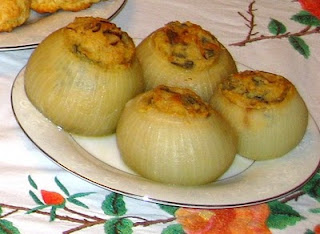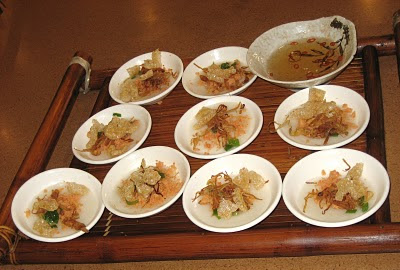The recipe actually just started as a regular cornbread stuffing. We bought store-bought cornbread (for simplicity's sake) and crumbled it and mixed with some various fun ingredients and then baked it all in a glass casserole/pie pan. It was delicious. It quickly became a Thanksgiving staple (like the Rosemary Cornish Hen). Then this year, I saw a recipe for roasted onions with stuffing inside and I thought it was a really clever idea. But I couldn't bear to part with our family's stuffing recipe. So with a little bit of tweaking, we now have this, a recipe for roasted Vidalia onions, filled with cornbread and sage stuffing.
If you want to skip the roasting and stuffing of the onions for the sake of time, feel free. I'll also warn you that hallowing out those onions was a huge tear-jerker. I'm not normally an onion crier--in fact, I've never teared up before from cutting onions--but while I was scooping out the inner layers of those onions, I could not stop crying. Those were some very real tears. But it was worth it.
This stuffing is sweet and savory, and the caramelized onions go so well with the sweetness of the corn and the earthiness of the sage. I also love the moist texture of this stuffing. Having the stuffing inside of the roasted Vidalia onions just put the icing on the cake, so to speak. It was perfect, and well worth the tears.
Roasted Onions
These instructions work for any number of onions. Just change your pan size based on your amount of onions. I used sweet Vidalia onions. Yellow onions work just as well. I wouldn't use white onions, however, as they don't have the same flavor.
To make the onions shells, cut and discards the tops and bottoms of the onions (about ¼ inch). Using a small ice cream scoop, scoop out the inner layers of the onions. Leave the outer 2 layers intact. The scooped-out onion can be sautéed and reserved for cooking. Don’t worry if you make a hole at the bottom of your onion shells.
To roast the onions, preheat the oven to 400°F. Arrange the onion shells open side up in a 9x13 baking pan. Add enough water to go up the onions one-quarter of the way. Add 1 tsp kosher/sea salt. Cover the pan with foil and bake until onions are tender, 20 to 30 minutes.
Cornbread and Sage Stuffing
Crumble an 8x8 pan of cornbread (we use store bought for simplicity) into a medium bowl.
Add about ¼ cup chopped sage, a dash of salt, and some ground black pepper.
In a separate bowl, beat 1 egg with ¼ cup heavy cream and ¾ cup chicken stock.
Pour over the cornbread mixture and stir to combine.
Meanwhile, sauté 1 cup chopped onions (this is where you can use the excess onions from above) in 2 tbsp butter. Add the onions to the cornbread mixture.
If using the roasted onions, place the roasted onions in a large enough pan to contain them, and then stuff the onions with the cornbread mixture. Bake for 35-40 minutes at 400°F (until golden on top and a toothpick inserted comes out clean).
The cornbread “stuffing” (really, it has more the texture of bread pudding) can be baked in a casserole dish at 400°F for 45 minutes.
Serves 4, with plenty of leftovers, or 8, as a side. The stuffing recipe can be used to stuff AT LEAST 8 large onions.
We just stuffed 4 onions and baked the rest of the stuffing in a 6 inch round casserole dish.
With buttermilk biscuit and cranberry relish
On the table, stuffed onions on the far side,
(pesto potato salad in the middle),
and cornbread stuffing baked in a small casserole dish in the front.
(pesto potato salad in the middle),
and cornbread stuffing baked in a small casserole dish in the front.
































